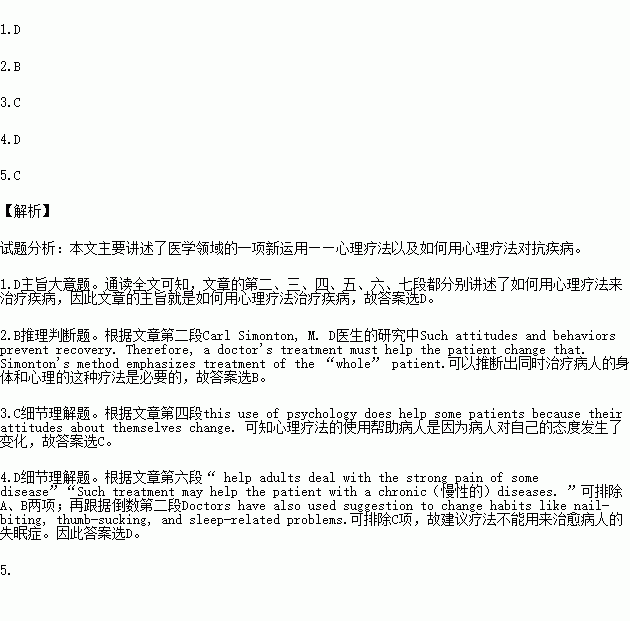题目内容
Psychology has a new application in the field of medicine. Many doctors, together with their patients, are looking for alternative methods of treatment of physical problems. In large hospitals, modern therapy seems to focus on the physical disease. Patients may feel they are treated like broken machines. Some doctors have recognized this as a problem. They are now using psychological therapy, in which the patient is working with the doctors against the disease with the help of medicine. The patient does not wait for the medicine and treatment to cure him or her, but instead the patient joins in the fight.
The doctor knows that a disease affects a patient's body physically. The body of the patient changes because of the disease. He is not only physically affected, but also has an emotional response to the disease. Because his mind is affected, his attitude and behavior change. The medical treatment might cure the patient's physical problems, but the patient's mind must fight the emotional ones. For example, the studies of one doctor, Carl Simonton, M. D., have shown that a typical cancer patient has predictable attitudes. She typically feels depressed, upset, and angry. Her constant depression makes her acts unfriendly toward her family, friends, doctors, and nurses. Such attitudes and behaviors prevent recovery. Therefore, a doctor's treatment must help the patient change that. Simonton's method emphasizes treatment of the “whole” patient.
The attitude of a cancer patient receiving radiation therapy, an X-ray treatment, can become more positive. The physician who is following Simonton's psychological treatment plan suggests that the patient imagine that he or she can see the tumor in the body. In the mental picture, the patient "sees" a powerful beam of radiation like a million bullets of energy. The patient imagines the beam hitting the tumor cells and causing them to shrink. For another cancer patient, Dr. Simonton asks him to imagine the medicine going from the stomach into the bloodstream and to the cancer cells. The patient imagines that the medicine is like an army fighting the diseased cells and sees the cancer cells gradually dying and his blood carry away the dead cells. Both the medical therapy and the patient's positive attitude fight the disease.
Doctors are not certain why this mental therapy works. However, this use of psychology does help some patients because their attitudes about themselves change. They become more confident because they use the power within their own minds to help stop the disease.
Another application of using the mind to help cure disease is the use of suggestion therapy. At first, the doctor helps the patient to concentrate deeply. The patient thinks only about one thing. He becomes so unaware of other things around him that he is asleep, or rather in a trance(催眠状态). Then the physician makes “a suggestion” to the patient about the medical problem. The patient's mind responds to the suggestion even after the patient is no longer in the trance. In this way, the patient uses his mind to help his body respond to treatment.
Doctors have learned that this use of psychology is helpful for both adults and children. For example, physicians have used suggestion to help adults deal with the strong pain of some disease. Furthermore, sometimes the adult patient worries about her illness so much that the anxiety keeps her from getting well. The right suggestions may help the patient to stop being anxious. Such treatment may help the patient with a chronic(慢性的)diseases. Asthma (哮喘) is an example of a chronic disorder. Asthma is a disease that causes the patient to have difficulty in breathing. The patient starts to cough and sometimes has to fight to get the air that he or she needs. Psychology can help relieve the symptoms of this disorder. After suggestion therapy, the asthma patient breathes more easily.
Physicians have learned that the psychological method is very useful in treating children. Children respond quickly to the treatment because they are fascinated by it. For example, Dr. Basil R. Collison has worked with 121 asthmatic children in Sydney, Australia, and had good results. Twenty-five of the children had Excellent results. They were able to breathe more easily, and they did not need medication. Another forty-three were also helped. The symptoms of the asthma occurred less frequently, and when they did, they were not as strong. Most of the children also felt better about themselves. Doctors have also used suggestion to change habits like nail-biting, thumb-sucking, and sleep-related problems.
Many professional medical groups have accepted the medical use of psychology and that psychology has important applications in medicine.
1. What does the passage mainly discuss?
A. How suggestion therapy benefits adults and children.
B. How modern therapy focuses on the disease.
C. Responses from the medical world.
D. How to use the mind against disease.
2.What can we learn from the studies of Carl Simonton, M. D.?
A. The medical treatment can cure the patient's mental disease.
B. The treatment of a patient by treating the body and the mind is necessary.
C. The mental treatment is more important than medical treatment.
D. Few patients have emotional response to the disease.
3.The use of psychological therapy is helpful to some patients in that .
A. the medical effect is better with psychological therapy than without it
B. the patients can see a powerful beam of radiation hitting their tumor cells
C. the patients' attitudes towards themselves have changed
D. the patients are easy to accept the methods the doctors use to treat them
4.It can be learned from the passage that suggestion therapy cannot be used to .
A. help adults deal with the strong pain of some diseases
B. help the patients with chronic diseases
C. help change some bad habits
D. help cure patients of insomnia
5.According to the passage, which of the following remains unknown so far?
A. The value of mental therapy.
B. The effectiveness of suggestion therapy.
C. The working principle of suggestion therapy.
D. The importance of psychology in medical treatment.
 目标测试系列答案
目标测试系列答案
